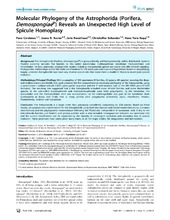| dc.description.abstract | Background: The Astrophorida (Porifera, Demospongiaep) is geographically and bathymetrically widely distributed. Systema Porifera currently includes five families in this order: Ancorinidae, Calthropellidae, Geodiidae, Pachastrellidae and Thrombidae. To date, molecular phylogenetic studies including Astrophorida species are scarce and offer limited sampling. Phylogenetic relationships within this order are therefore for the most part unknown and hypotheses based on morphology largely untested. Astrophorida taxa have very diverse spicule sets that make them a model of choice to investigate spicule evolution. Methodology/Principal Findings: With a sampling of 153 specimens (9 families, 29 genera, 89 species) covering the deepand shallow-waters worldwide, this work presents the first comprehensive molecular phylogeny of the Astrophorida, using a cytochrome c oxidase subunit I (COI) gene partial sequence and the 59 end terminal part of the 28S rDNA gene (C1-D2 domains). The resulting tree suggested that i) the Astrophorida included some lithistid families and some Alectonidae species, ii) the sub-orders Euastrophorida and Streptosclerophorida were both polyphyletic, iii) the Geodiidae, the Ancorinidae and the Pachastrellidae were not monophyletic, iv) the Calthropellidae was part of the Geodiidae clade (Calthropella at least), and finally that v) many genera were polyphyletic (Ecionemia, Erylus, Poecillastra, Penares, Rhabdastrella, Stelletta and Vulcanella). Conclusion: The Astrophorida is a larger order than previously considered, comprising ca. 820 species. Based on these results, we propose new classifications for the Astrophorida using both the classical rank-based nomenclature (i.e., Linnaean classification) and the phylogenetic nomenclature following the PhyloCode, independent of taxonomic rank. A key to the Astrophorida families, sub-families and genera incertae sedis is also included. Incongruences between our molecular tree and the current classification can be explained by the banality of convergent evolution and secondary loss in spicule evolution. These processes have taken place many times, in all the major clades, for megascleres and microscleres. | en_US |

